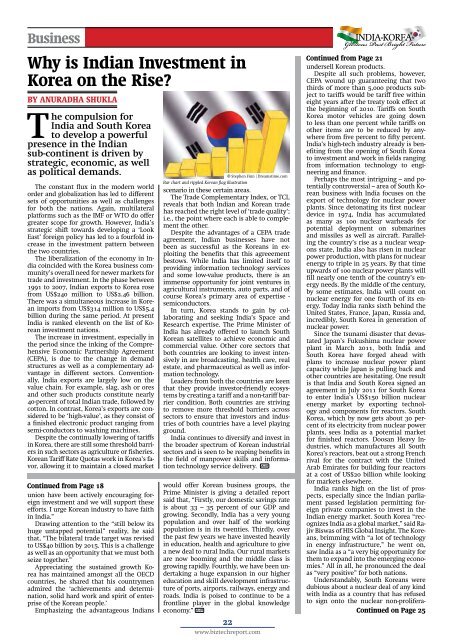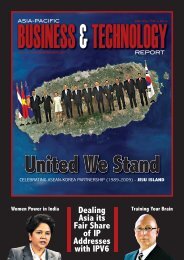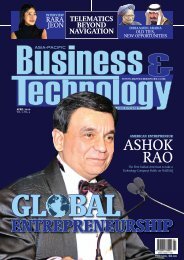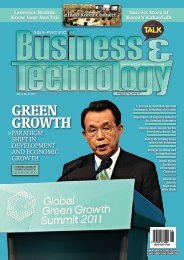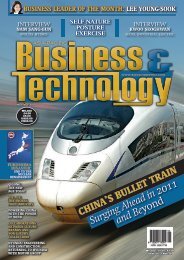INDIA-KOREA - Asia-Pacific Business and Technology Report
INDIA-KOREA - Asia-Pacific Business and Technology Report
INDIA-KOREA - Asia-Pacific Business and Technology Report
You also want an ePaper? Increase the reach of your titles
YUMPU automatically turns print PDFs into web optimized ePapers that Google loves.
<strong>Business</strong><br />
Why is Indian Investment in<br />
Korea on the Rise?<br />
by Anuradha Shukla<br />
The compulsion for<br />
India <strong>and</strong> South Korea<br />
to develop a powerful<br />
presence in the Indian<br />
sub-continent is driven by<br />
strategic, economic, as well<br />
as political dem<strong>and</strong>s.<br />
The constant flux in the modern world<br />
order <strong>and</strong> globalization has led to different<br />
sets of opportunities as well as challenges<br />
for both the nations. Again, multilateral<br />
platforms such as the IMF or WTO do offer<br />
greater scope for growth. However, India’s<br />
strategic shift towards developing a ‘Look<br />
East’ foreign policy has led to a fourfold increase<br />
in the investment pattern between<br />
the two countries.<br />
The liberalization of the economy in India<br />
coincided with the Korea business community’s<br />
overall need for newer markets for<br />
trade <strong>and</strong> investment. In the phase between<br />
1991 to 2007, Indian exports to Korea rose<br />
from US$240 million to US$2.46 billion.<br />
There was a simultaneous increase in Korean<br />
imports from US$314 million to US$5.4<br />
billion during the same period. At present<br />
India is ranked eleventh on the list of Korean<br />
investment nations.<br />
The increase in investment, especially in<br />
the period since the inking of the Comprehensive<br />
Economic Partnership Agreement<br />
(CEPA), is due to the change in dem<strong>and</strong><br />
structures as well as a complementary advantage<br />
in different sectors. Conventionally,<br />
India exports are largely low on the<br />
value chain. For example, slag, ash or ores<br />
<strong>and</strong> other such products constitute nearly<br />
40-percent of total Indian trade, followed by<br />
cotton. In contrast, Korea’s exports are considered<br />
to be ‘high-value’, as they consist of<br />
a finished electronic product ranging from<br />
semi-conductors to washing machines.<br />
Despite the continually lowering of tariffs<br />
in Korea, there are still some threshold barriers<br />
in such sectors as agriculture or fisheries.<br />
Korean Tariff Rate Quotas work in Korea’s favor,<br />
allowing it to maintain a closed market<br />
Continued from Page 21<br />
undersell Korean products.<br />
Despite all such problems, however,<br />
CEPA wound up guaranteeing that two<br />
thirds of more than 5,000 products subject<br />
to tariffs would be tariff free within<br />
eight years after the treaty took effect at<br />
the beginning of 2010. Tariffs on South<br />
Korea motor vehicles are going down<br />
to less than one percent while tariffs on<br />
other items are to be reduced by anywhere<br />
from five percent to fifty percent.<br />
India’s high-tech industry already is benefiting<br />
from the opening of South Korea<br />
to investment <strong>and</strong> work in fields ranging<br />
from information technology to engineering<br />
<strong>and</strong> finance.<br />
Perhaps the most intriguing – <strong>and</strong> potentially<br />
controversial – area of South Korean<br />
business with India focuses on the<br />
export of technology for nuclear power<br />
plants. Since detonating its first nuclear<br />
device in 1974, India has accumulated<br />
as many as 100 nuclear warheads for<br />
potential deployment on submarines<br />
<strong>and</strong> missiles as well as aircraft. Paralleling<br />
the country’s rise as a nuclear weapons<br />
state, India also has risen in nuclear<br />
power production, with plans for nuclear<br />
energy to triple in 25 years. By that time<br />
upwards of 100 nuclear power plants will<br />
fill nearly one tenth of the country’s energy<br />
needs. By the middle of the century,<br />
by some estimates, India will count on<br />
nuclear energy for one fourth of its energy.<br />
Today India ranks sixth behind the<br />
United States, France, Japan, Russia <strong>and</strong>,<br />
incredibly, South Korea in generation of<br />
nuclear power.<br />
Since the tsunami disaster that devastated<br />
Japan’s Fukushima nuclear power<br />
plant in March 2011, both India <strong>and</strong><br />
South Korea have forged ahead with<br />
plans to increase nuclear power plant<br />
capacity while Japan is pulling back <strong>and</strong><br />
other countries are hesitating. One result<br />
is that India <strong>and</strong> South Korea signed an<br />
agreement in July 2011 for South Korea<br />
to enter India’s US$150 billion nuclear<br />
energy market by exporting technology<br />
<strong>and</strong> components for reactors. South<br />
Korea, which by now gets about 30 percent<br />
of its electricity from nuclear power<br />
plants, sees India as a potential market<br />
for finished reactors. Doosan Heavy Industries,<br />
which manufactures all South<br />
Korea’s reactors, beat out a strong French<br />
rival for the contract with the United<br />
Arab Emirates for building four reactors<br />
at a cost of US$20 billion while looking<br />
for markets elsewhere.<br />
India ranks high on the list of prospects,<br />
especially since the Indian parliament<br />
passed legislation permitting foreign<br />
private companies to invest in the<br />
Indian energy market. South Korea “recognizes<br />
India as a global market,” said Rajiv<br />
Biswas of HIS Global Insight. The Koreans,<br />
brimming with “a lot of technology<br />
in energy infrastructure,” he went on,<br />
saw India as a “a very big opportunity for<br />
them to exp<strong>and</strong> into the emerging economies.”<br />
All in all, he pronounced the deal<br />
as “very positive” for both nations.<br />
Underst<strong>and</strong>ably, South Koreans were<br />
dubious about a nuclear deal of any kind<br />
with India as a country that has refused<br />
to sign onto the nuclear non-prolifera-<br />
Continued on Page 25<br />
Continued from Page 18<br />
union have been actively encouraging foreign<br />
investment <strong>and</strong> we will support these<br />
efforts. I urge Korean industry to have faith<br />
in India.”<br />
Drawing attention to the “still below its<br />
huge untapped potential” reality, he said<br />
that, “The bilateral trade target was revised<br />
to US$40 billion by 2015. This is a challenge<br />
as well as an opportunity that we must both<br />
seize together.”<br />
Appreciating the sustained growth Korea<br />
has maintained amongst all the OECD<br />
countries, he shared that his countrymen<br />
admired the ‘achievements <strong>and</strong> determination,<br />
solid hard work <strong>and</strong> spirit of enterprise<br />
of the Korean people.’<br />
Emphasizing the advantageous Indians<br />
© Stephen Finn | Dreamstime.com<br />
Bar chart <strong>and</strong> rippled Korean flag illustration<br />
scenario in these certain areas.<br />
The Trade Complementary Index, or TCI,<br />
reveals that both Indian <strong>and</strong> Korean trade<br />
has reached the right level of ‘trade quality’;<br />
i.e., the point where each is able to complement<br />
the other.<br />
Despite the advantages of a CEPA trade<br />
agreement, Indian businesses have not<br />
been as successful as the Koreans in exploiting<br />
the benefits that this agreeement<br />
bestows. While India has limited itself to<br />
providing information technology services<br />
<strong>and</strong> some low-value products, there is an<br />
immense opportunity for joint ventures in<br />
agricultural instruments, auto parts, <strong>and</strong> of<br />
course Korea’s primary area of expertise -<br />
semiconductors.<br />
In turn, Korea st<strong>and</strong>s to gain by collaborating<br />
<strong>and</strong> seeking India’s Space <strong>and</strong><br />
Research expertise. The Prime Minister of<br />
India has already offered to launch South<br />
Korean satellites to achieve economic <strong>and</strong><br />
commercial value. Other core sectors that<br />
both countries are looking to invest intensively<br />
in are broadcasting, health care, real<br />
estate, <strong>and</strong> pharmaceutical as well as information<br />
technology.<br />
Leaders from both the countries are keen<br />
that they provide investor-friendly ecosystems<br />
by creating a tariff <strong>and</strong> a non-tariff barrier<br />
condition. Both countries are striving<br />
to remove more threshold barriers across<br />
sectors to ensure that investors <strong>and</strong> industries<br />
of both countries have a level playing<br />
ground.<br />
India continues to diversify <strong>and</strong> invest in<br />
the broader spectrum of Korean industrial<br />
sectors <strong>and</strong> is seen to be reaping benefits in<br />
the field of manpower skills <strong>and</strong> information<br />
technology service delivery. A-P<br />
would offer Korean business groups, the<br />
Prime Minister is giving a detailed report<br />
said that, “Firstly, our domestic savings rate<br />
is about 33 – 35 percent of our GDP <strong>and</strong><br />
growing. Secondly, India has a very young<br />
population <strong>and</strong> over half of the working<br />
population is in its twenties. Thirdly, over<br />
the past few years we have invested heavily<br />
in education, health <strong>and</strong> agriculture to give<br />
a new deal to rural India. Our rural markets<br />
are now booming <strong>and</strong> the middle class is<br />
growing rapidly. Fourthly, we have been undertaking<br />
a huge expansion in our higher<br />
education <strong>and</strong> skill development infrastructure<br />
of ports, airports, railways, energy <strong>and</strong><br />
roads. India is poised to continue to be a<br />
frontline player in the global knowledge<br />
economy.” A-P<br />
22<br />
www.biztechreport.com<br />
<strong>INDIA</strong>-<strong>KOREA</strong><br />
Glorious Past Bright Future


